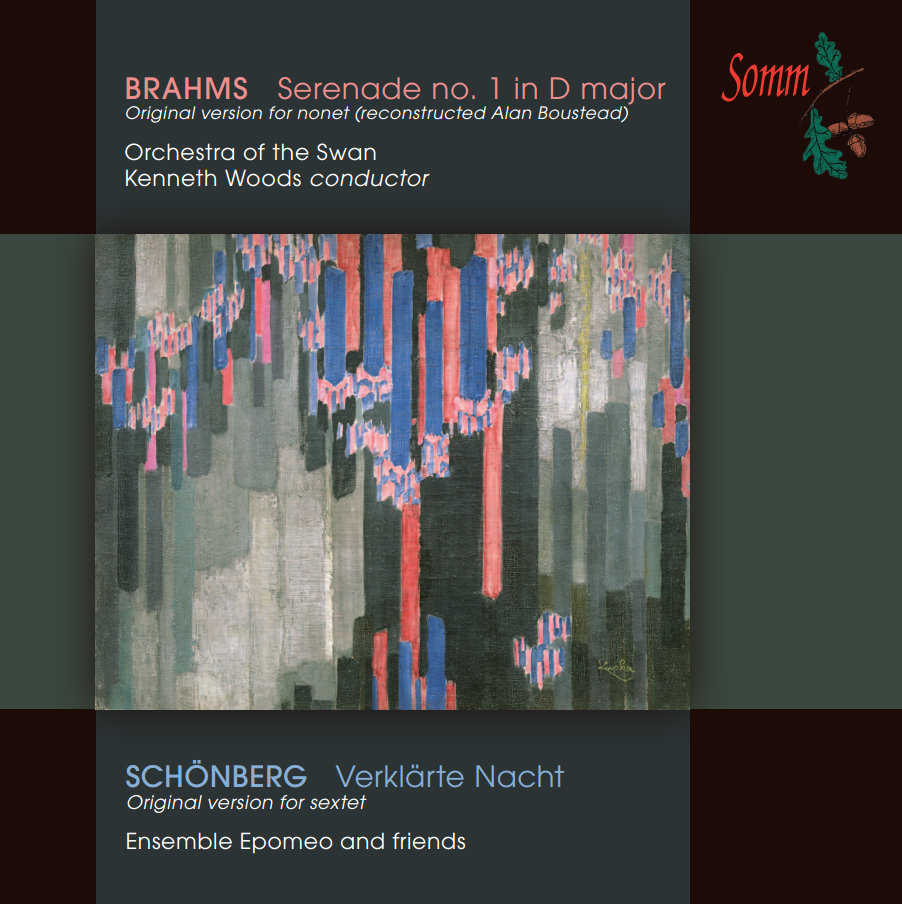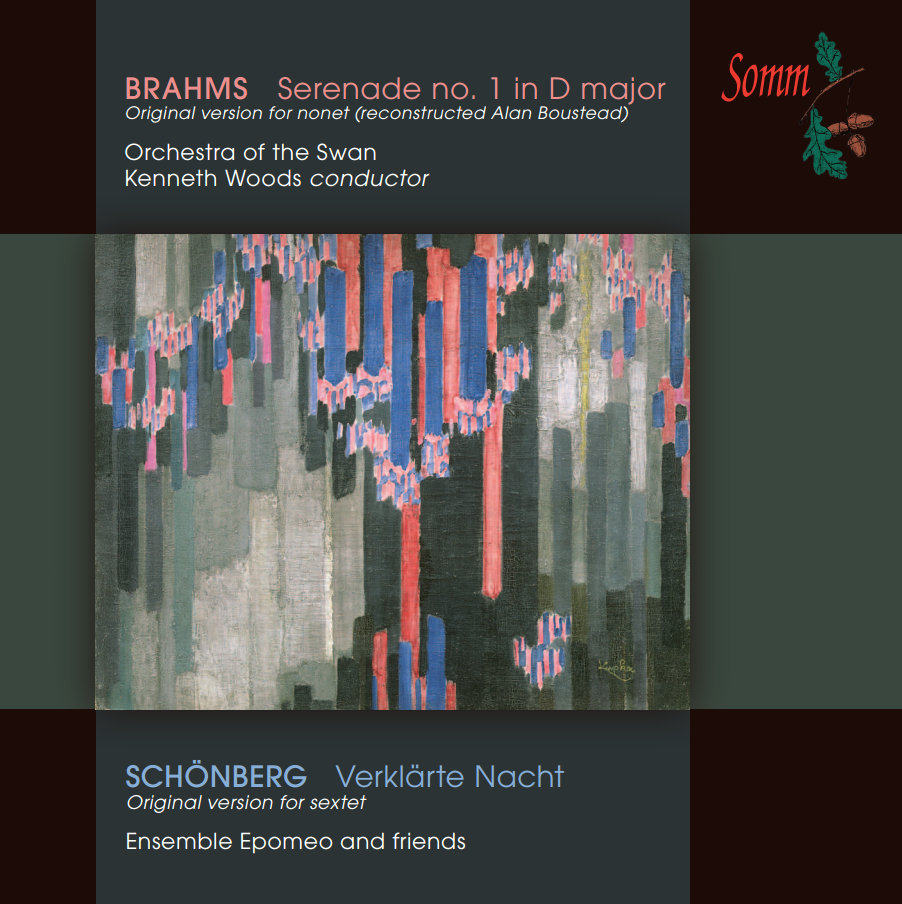[Click here to Explore the Score of the companion work on this CD- Brahms’s Serenade No. 1 in D major, Original Version for Nonet)
The Brahms-Wagner rivalry was largely an affair of the press, whipped up by critics like the Brahmsian Eduard Hanslick and his pro-Wagnerian rivals. Brahms actually professed great admiration for Wagner’s music on many occasions. Nonetheless, there was a time when the two men were perceived as embodying irreconcilable aesthetic approaches. In the end, it was Arnold Schönberg who succeeded in Verklärte Nacht and the works which followed it, in marrying the joint influences of Wagner and Brahms as no one had before.
Brahms’s music- its density, richness and rigour- had a profound influence on Arnold Schönberg’s development, and his engagement with Brahms’s music continued throughout his career. Schönberg’s writings about the music of Brahms, particularly his essay “Brahms the Progressive,” are among the most illuminating analyses of the older composer’s work, and his arrangement of Brahms’s Piano Quartet in G minor for full orchestra has become a staple of the orchestral repertoire. From Brahms, Schönberg learned the creative possibilities of the perpetual manipulation and development of tiny motivic cells, an approach that would eventually form the underpinning of the 12-tone technique. This kind of rigorously detailed approach to composition is already fully developed in Verklärte Nacht. Brahms’s favourite technique of “developing variation” (a term coined by Schönberg which refers to the constant development of small musical ideas throughout a piece) is also essential in Schönberg’s music. Brahms’s approach to most classical forms differs from that of his forerunners in that Brahms’s music is almost never simply expository nor recapitulatory: the musical material starts to develop and evolve almost as soon as the piece starts, and the process of constant change carries right through to the end.
Originally written as a string sextet (for two violins, two violas and two cellos) over just three weeks in 1899, and arranged by the composer in 1917 for large string orchestra, Verklärte Nacht (Transfigured Night) takes its title from a poem by Richard Dehmel, published in the collection Weib und Welt (Woman and World) in 1896. Modern readers might be amused to read that Dehmel was tried for obscenity and blasphemy when Weib und Welt was published. While the acknowledgment and exploration of female sexuality in Verklärte Nacht and some of Dehmel’s other poems might have raised eyebrows, the worldview expressed in them, and the association of female sexuality with shame and guilt, now seems rather conservative and paternalistic. Modern readers may find the poem’s apotheosis, in which “the man” forgives and accepts “the woman” in spite of her sexual transgressions both deeply touching and hugely condescending. Nonetheless, Schönberg’s inspired reaction to Dehmel’s poetry works its own transfiguration on its literary model, elevating and intensifying the meaning and symbolism of the original. It is hard to overstate Dehmel’s influence on Schönberg’s evolution in the late 1890’s. Schönberg had set several poems by Dehmel in 1897, and 1899 is sometimes called his “Dehmeljahr,” (“year of Dehmel”) in which he spent almost the entire year setting poems from Weib und Welt, culminating in the breakthrough that was Verklärte Nacht. Musicologist Walter Frisch says that Schönberg’s “remarkable development that year …grew directly out his search for a musical language approapriate to the poetry of Weib und welt,” inspired by Dehmel’s success in combining erotic sensuality and intensity of expression with clear formal structure.
A work like Verklärte Nacht might seem to be a huge departure from the classical forms preferred by Brahms- Webern even described it as a “free fantasia.” However, although the work is programmatic, with obvious influences of Wagner and Liszt, it is hardly free. Schönberg found in Dehmel’s poem a way to combine elements of two traditional, strict, even Brahmsian, musical forms: the fundamental structure is that of a Rondo (or A-B-A-C-A), incorporating elements of Sonata-Allegro form . The “A” sections set the tone and lay out the narrative of the work (Schönberg described them as “epic” in character), while the “B” section represents the woman’s confession of her illegitimate pregnancy and the “C” section depicts the man’s tender forgiveness and acceptance of her. It’s not only that lucid form in which Brahms’s influence can be felt, but in the way that Schönberg begins the development and transformation of his material in the work’s opening bars and continues the process throughout. The “transfiguration” of the work’s title is manifest in the way in which the “A” section changes character each time it occurs- beginning with mystery and dread, returning in anguish and desperation and completing its journey in radiant joy. The piece is tonal—beginning in D minor and ending in D major—but also shows Schönberg exploring completely new harmonic territory. In fact, the piece was originally considered unfit for performance because of Schönberg’s use of an unresolved “ninth” chord. Early listeners may also have been shocked by the intensity and density of Schönberg’s counterpoint- passionate and sensuous as the piece is, there is already a strong element of Schönberg-ian “difficulty” present in the music. What sets Verklärte Nacht apart from the works which precede it is the extent to which, as successfully as it marries Wagnerian chromaticism and narrative to Brahmsian rigour, the compositional voice is clearly the fully-formed and completely original one belonging to Arnold Schönberg.


Recent Comments